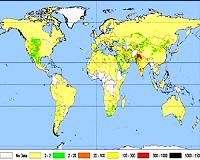| . |  |
. |
Washington DC (SPX) Sep 28, 2010 A decade-long, multibillion dollar effort to restore the Florida Everglades has made tangible albeit slow progress, but additional projects need completion before substantial benefits are seen, says a new congressionally mandated report from the National Research Council. Challenges in achieving targets for both water quality and water flow have become more apparent, requiring further scientific analysis to determine the repercussions of trading off one for the other. Although important scientific advances have been made, continued decline of some aspects of the ecosystem, such as water quality and endangered snail kite populations, make it critical to accelerate ecological improvements. The report is the third biennial evaluation of progress made by the Comprehensive Everglades Restoration Plan (CERP), a joint federal and state project that aims to reverse the ecosystem's decline while continuing to meet growing demands for clean water and flood control. Launched in 2000 by the U.S. Army Corps of Engineers and the South Florida Water Management District, CERP is a multiorganization planning process that comprises approximately 50 major projects to be completed over the next several decades. "One of the main objectives in restoring the Everglades is 'getting the water right,' which calls for increasing the amount of freshwater that flows through the system while meeting water quality goals," said Frank Davis, chair of the committee that wrote the report and a professor at the Bren School of Environmental Science and Management at the University of California, Santa Barbara. "But, getting enough water to the right places at the right time and attaining water quality goals throughout the entire ecosystem is proving to be more difficult and expensive than originally anticipated. It will likely take several decades and a continued commitment to systemwide pollution management, storage, and water quality treatment." After assessing the overall CERP and non-CERP efforts to restore the southern Florida ecosystem, the committee concluded that although progress has been slow over the past two years, improvements have been made in the pace of implementation, the relationship between federal and state partners, and research efforts. Four CERP projects are under construction, and pilot projects are addressing important design uncertainties. Several projects that serve as foundations to the plan are also under way, most notably the 1-mile Tamiami Trail bridge that is part of the Mod Waters project. However, only sparse natural system restoration benefits have resulted to date from the current construction. The committee also found challenges for CERP in improving water flow and restoring water quality in the ecosystem. Although increasing water storage and associated water treatment is a major near-term priority, the reduced area and natural water storage capacity of the modern Everglades make evenly distributed restoration infeasible. Conditions may even worsen in some areas to achieve the desired outcomes in others. The current extent of stormwater treatment areas (STAs) that remove phosphorus from the water is insufficient to treat existing water flow in the Everglades Protection Area, the report says. With increased volumes of water planned to enter the ecosystem as part of CERP, an estimated 54,000 additional acres of STAs would be required - costing approximately $1.1 billion to construct and $27 million per year to operate and maintain. Therefore, the committee recommended a comprehensive cost-effectiveness analysis to optimize restoration outcomes given state and federal financial constraints. The committee also suggested research to assess STA sustainability and performance and improve practices that help control phosphorus and other nutrients. In addition, the River of Grass initiative, which includes the purchase of nearly 27,000 acres from U.S. Sugar, could provide additional land for water storage and treatment. To help officials weigh the effects of simultaneous restoration projects on multiple ecosystem components, the report calls for research on the associated trade-offs from a whole ecosystem perspective, in particular the consequences of reducing water quantities while maintaining sufficient water quality and, conversely, reducing the quality of water in the ecosystem while maintaining sufficient flow. Furthermore, research should explore the degree to which negative consequences of these actions are reversible and on what time frames. Improved tools to help officials analyze decisions are needed to weigh the effects of restoration projects on multiple ecosystem components, including habitat conditions, threatened species, and features such as tree islands.
Share This Article With Planet Earth
Related Links National Academy of Sciences Water News - Science, Technology and Politics
 Groundwater Depletion Rate Accelerating Worldwide
Groundwater Depletion Rate Accelerating WorldwideWashington DC (SPX) Sep 28, 2010 In recent decades, the rate at which humans worldwide are pumping dry the vast underground stores of water that billions depend on has more than doubled, say scientists who have conducted an unusual, global assessment of groundwater use. These fast-shrinking subterranean reservoirs are essential to daily life and agriculture in many regions, while also sustaining streams, wetlands, and eco ... read more |
|
| The content herein, unless otherwise known to be public domain, are Copyright 1995-2010 - SpaceDaily. AFP and UPI Wire Stories are copyright Agence France-Presse and United Press International. ESA Portal Reports are copyright European Space Agency. All NASA sourced material is public domain. Additional copyrights may apply in whole or part to other bona fide parties. Advertising does not imply endorsement,agreement or approval of any opinions, statements or information provided by SpaceDaily on any Web page published or hosted by SpaceDaily. Privacy Statement |